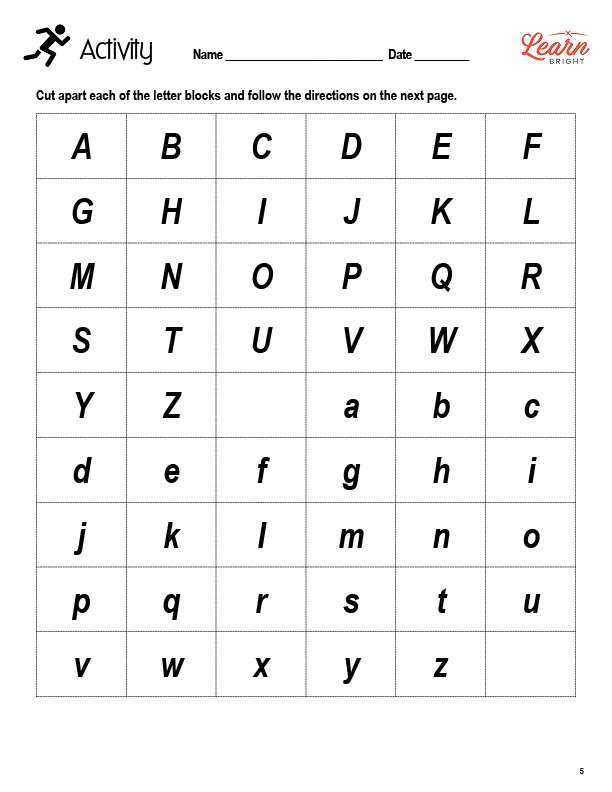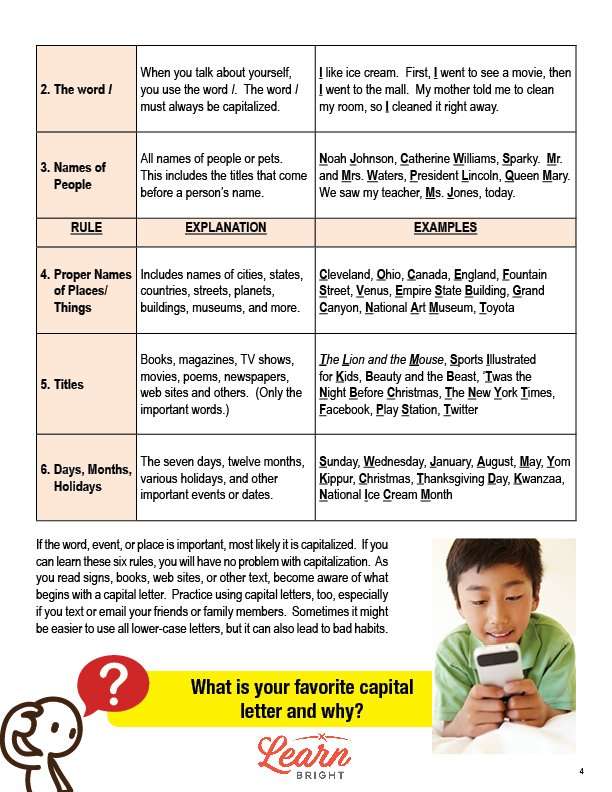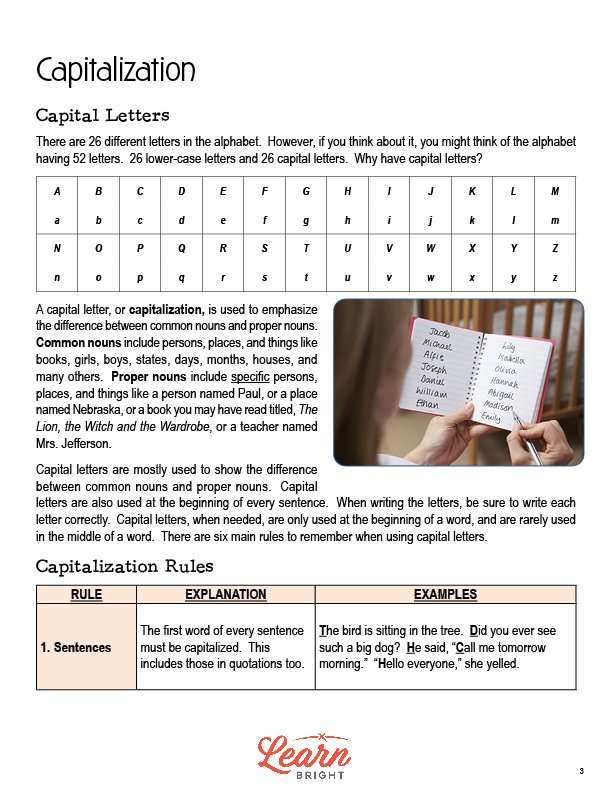Description
What our Capitalization (Grades 2-3) lesson plan includes
Lesson Objectives and Overview: Capitalization for grades 2-3 introduces students to the differences between lower-case letters and capital letters. Students who are already able to recognize the difference will begin to learn when and what to capitalize. At the end of this lesson, students will be able to identify the difference between a capital and lower-case letter and use capitals correctly at the beginning of sentences and for proper nouns. This lesson is for students in 2nd grade and 3rd grade.
Classroom Procedure
Every lesson plan provides you with a classroom procedure page that outlines a step-by-step guide to follow. You do not have to follow the guide exactly. The guide helps you organize the lesson and details when to hand out worksheets. It also lists information in the orange box that you might find useful. You will find the lesson objectives, state standards, and number of class sessions the lesson should take to complete in this area. In addition, it describes the supplies you will need as well as what and how you need to prepare beforehand. For this lesson, the supplies you will need are scissors, glue, and the handouts. To prepare for this lesson ahead of time, you can gather the supplies and copy the handouts.
Options for Lesson
Included with this lesson is an “Options for Lesson” section that lists a number of suggestions for activities to add to the lesson or substitutions for the ones already in the lesson. One optional addition to this lesson is to have your students identify objects or things in your classroom, the school, or the outdoors that would need to be written using capital letters. You can also have students use their current reading material and identify correctly capitalized words. Students can also write sentences that only contain lower case letters and then exchange them with another student for correction. Finally, you can assign your students one or two capital letters each and have them turn them into a drawing that includes some items that start with those letters.
Teacher Notes
The teacher notes page includes a paragraph with additional guidelines and things to think about as you begin to plan your lesson. It notes that you may wish to adjust the lesson depending on the grade level of your students. While older students need to understand how to capitalize titles, younger students can focus on the rules for capitalizing proper nouns. This page also includes lines that you can use to add your own notes as you’re preparing for this lesson.
CAPITALIZATION (GRADES 2-3) LESSON PLAN CONTENT PAGES
Capital Letters
The Capitalization (Grades 2-3) lesson plan includes two content pages. It begins by stating that, while there are 26 letters in our alphabet, we have 52 symbols that we use — 26 lower case letters and 26 upper case letters. So why do we have upper case, or capital, letters? We use capital letters to emphasize the difference between common and proper nouns. Common nouns include words like books, girls, boys, states, and more. Proper nouns are the specific things in these categories. For example, the word “person” is a common noun, but the word “Paul” is a proper noun, because Paul is a specific person. The lesson also includes several other examples. In addition to using them for proper nouns, we also use capital letters at the beginning of each sentence. It is important for students to use capital letters correctly. We almost always use them at the beginning of words, and almost never in the middle of a word. We have six main rules for capitalization.
Capitalization Rules
The next section of the lesson delves into the six capitalization rules. These rules are shown as a helpful and easy-to-read chart. The chart includes a column for the rule, an explanation of the rule, and examples. The first rule has to do with sentences. It states that you have to capitalize the first word of every sentence, even in quotations. The second rule has to do with the word “I”. You use this word to talk about yourself and you must capitalize it, no matter where it appears in a sentence. The third rule is about people’s names. You have to capitalize names of people, pets, and their titles!
The fourth rule is about proper names of places and things. You must capitalize the names of specific cities, states, countries, streets, planets, buildings, museums and more. The fifth rule has to do with titles. You have to capitalize the important words in the titles of books, magazines, TV shows, movies, poems, newspapers, and websites. Students can learn more about the specific rules for capitalizing titles in another lesson about capitalizing titles. The sixth and final rule is about days, months, and holidays. You must capitalize the names of the seven days of the week, the twelve months, holidays, and other important days and events.
The lesson concludes by noting that a good general rule to follow is that you should almost always capitalize important words. Students who learn the six rules outlined in this lesson should be able to properly capitalize almost everything. Students should pay attention to the capital letters they see in titles, in their reading, and in other places. They should also practice using capital letters at home and in text messages.
CAPITALIZATION (GRADES 2-3) LESSON PLAN WORKSHEETS
The Capitalization (Grades 2-3) lesson plan includes three worksheets: an activity worksheet, a practice worksheet, and a homework assignment. You can refer to the guide on the classroom procedure page to determine when to hand out each worksheet.
MISSING LETTER ACTIVITY WORKSHEET
Students will begin the activity by cutting out both lower and upper case letters. Next, they will read the given sentences and glue the missing letter in each sentence into the space next to the sentence. They must make sure to both use the correct letter and the correct case for each blank. They will use all of the letters they cut out. The lesson includes two examples for students to reference.
Students may also work in pairs for the activity if you’d prefer.
CAPITALIZATION (GRADES 2-3) PRACTICE WORKSHEET
For the practice worksheet, students will complete two exercises. The first exercise asks students to read three versions of various sentences and circle the correctly capitalized version. The second exercise asks students to briefly explain each of the six capitalization rules covered in this lesson. This will test their knowledge and understanding of the lesson material.
FIND THE CAPITAL LETTER HOMEWORK ASSIGNMENT
The homework assignment asks students to find five people, places, or things in their homes, towns, or neighborhoods that begin with one of the letters in each provided group of letters. They can try looking at book titles, street names, people’s names, and more! Next, students will read a paragraph and underline any words that are capitalized correctly and circle any words that need to be capitalized but aren’t.
Worksheet Answer Keys
This lesson plan includes answer keys for the activity worksheet, the practice worksheet, and the homework assignment. If you choose to administer the lesson pages to your students via PDF, you will need to save a new file that omits these pages. Otherwise, you can simply print out the applicable pages and keep these as reference for yourself when grading assignments.










